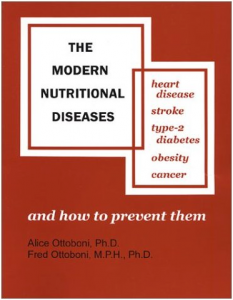Ketone Bodies and Ketosis: Ketones are organic chemicals in which an interior carbon in a molecule forms a double bond with an oxygen molecule. Acetone, a familiar chemical, is the smallest ketone possible. It is composed of three carbons, with the double bond to oxygen on the middle carbon. Biological ketone bodies include acetone, larger ketones, and biochemicals that can become ketones. The most important of the ketone bodies are hydroxybutyrate and acetoacetate, both of which are formed from condensation of two acetyl CoA molecules. Acetone is formed from a nonenzymatic decarboxylation of acetoacetate.
Ketone bodies are fuel molecules that can be used for energy by all organs of the body except the liver. The production of ketone bodies is a normal, natural, and important biochemical pathway in animal biochemistry (17, p. 577). Small quantities of ketone bodies are always present in the blood, with the quantity increasing as hours without food increase. During fasting or carbohydrate deprivation, larger amounts of ketone bodies are produced to provide the energy that is normally provided by glucose.
Excessive levels of circulating ketone bodies can result in ketosis, a condition in which the quantity of circulating ketone bodies is greater than the quantity the organs and tissues of the body need for energy. People who go on extremely low-carbohydrate diets to lose a large excess of body fat usually go into a mild ketosis that moderates as weight is lost. There is no scientific evidence that a low-carbohydrate diet is capable of producing sufficient ketone bodies to be harmful.
Excess ketone bodies are excreted by the kidneys and lungs. Exhaled acetone gives the breath a characteristic, sweetish odor. If ketosis is maintained for prolonged periods, as can occur in untreated type-1 diabetes (insulin-dependent diabetes), the blood can become very acidic. This is a life-threatening disorder is known as ketoacidosis.
Ketone bodies that are excreted in the urine and the breath carry with them the calories they contain. These are calories that were counted in the diet but were made unavailable to the body by being excreted before being used. In effect, the body actually receives fewer calories than the amount calculated. Thus, for individuals with normal pancreatic function, a ketogenic (low-carbohydrate) diet containing a given number of calories will result in greater weight loss than a nonketogenic diet (high-carbohydrate) containing the same number of calories. This difference in apparent caloric content between low-carbohydrate and high-carbohydrate diet plans has given rise to the observation that ketogenic diets have a metabolic advantage over nonketogenic diets with regard to weight loss.
Dietetic versus Diabetic Ketosis: The nutrition community has fostered the popular misconception that ketone-body production, per se, is an undesirable metabolic circumstance. It has warned that the formation of ketone bodies is a dangerous consequence of low-carbohydrate diets in an effort to discredit any recommendations that deviate from official dietary recommendations. As a result, the public has come to view formation of ketone bodies as a symptom of a pathological condition rather than a normal attempt by the body to satisfy its demands for energy when glucose supplies are short. This unfortunate misunderstanding stems from allegations that brief periods of dietary ketosis from diets low in carbohydrates have the same medical significance as diabetic ketosis. These allegations are foundationless and grossly in error.
There is no question that the ketosis of type-1 diabetes is undesirable and dangerous. In type-1 diabetes, the ability of the pancreas to make insulin is either diminished or absent. The mechanism by which ketone bodies are formed in type-1 diabetes is similar to that which occurs with a low-carbohydrate diet, as diagrammed in Figure 6-5. In the absence of insulin, fatty acids are mobilized and degraded, excess acetyl CoA is produced, and the excess is directed to HMG CoA and ketone bodies and potentially to ketoacidosis.
Diabetic ketosis is the body’s plaintive call for insulin administration. It is a warning signal that insulin levels have been permitted to fall too low and blood sugar levels are too high and out of control. This is a medical emergency. If insulin is not promptly administered and blood glucose brought under control, the insufficiency of insulin could lead to life-threatening physiologic responses, one of which is ketoacidosis.
Dietary ketosis is an entirely different condition because it occurs in people with sound pancreatic function with an ample supply of insulin. If glucose is not supplied by the diet, blood glucose levels drop. As a result of low blood glucose, insulin drops to a lower level and its counterpart hormone, glucagon, assumes control.
To spare glucose by providing a substitute energy source, glucagon stimulates the degradation of fatty acids and the conversion of surplus acetyl CoA to ketone bodies (Figure 6-5). It is only when glucose sources are severely restricted that excess ketone bodies are produced and the acetone odor in the breath becomes noticeable.
Dietary ketosis is the body’s request not for insulin but for more glucose. It is a signal that the glucose supply is insufficient and, as a result, the body is burning fatty acids mobilized from fat storage sites for energy. If glucose sources are not supplied, mobilization and degradation of fatty acids continue. In a starvation situation, this is a serious matter. However, for healthy people on low-carbohydrate diets, the only result of ketone body production is loss of body fat. In summary, diabetic ketosis is a call for more insulin because the blood glucose level is dangerously high. Dietary ketosis, on the other hand, is a call for more glucose because the blood glucose level is becoming low.

